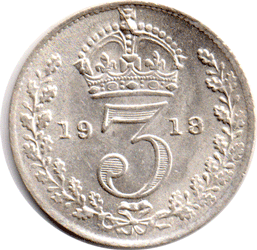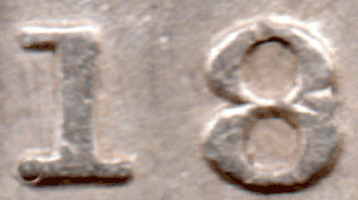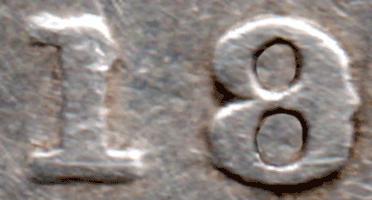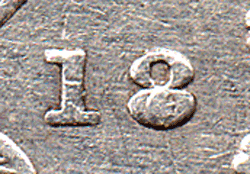|
Michael Coins Ltd |
![]() Other Lists
Other Lists
COIN CLUB
The 1918 Date variety - or anomaly !
|
|
|
|
|
ST 1918 B - Rev.
|
ST 1918 B - 9
|
|
|
|
|
|
ST 1918 B - 18A |
ST 1918 B - 18 B |
|
|
|
|
|
ST 1918 B - 18 C |
ST 1918 B - 18 D |
|
|
|
ST 1918 B - 18 E |
Davies lists in his book "British Silver Coins since 1816" (published1982) the
variety in the silver threepence section - under 1919 - last '9' over '8' [D. 1933].
Over the years I have examined over 1000 silver 3d of 1918 & 1919 and have never
come across this variety. The closest I have come to finding this variety is with the
above coins.
In 20 plus years I have found only these FOUR examples of what I think he might
have considered as last '9' over '8' but to my mind they are NOT an example of
9 over 8 or even 8 over 9.
I would suggest that they are an example of a small "foreign matter", i.e. a tiny piece
of grit, dust, dirt, etc. that has got embedded in the outside right centre section of the 8.
Over a period of die strikings the "foreign matter" has been added to. I am fortunate to
have what I consider as ST 1918 B -18 A, an early example where the "matter" is small
and then to have progressive examples where the "matter" builds up ! I notice that
ST 1918 B - 18C & 18D have a faint die crack that runs from the foot of the 1 (one),
along the field and into the lower part of the 8 and eventually out the other side.
If this were ever to be consider this variety as 9 over 8 or 8 over 9 one only has to look
at the picture of a 9, that I show above, to see that if it were an over or under a 9 the
LARGE bulbous tail of the 9 would have to show within the inner lower section of the 8
and there is nothing extra within the lower left section of the 8.
Davies also lists that the reverse die for 1918 and 1918 ONLY is with reverse C
and that in 1919 the reverse die, in fact, reverts back to the use of reverse B only.
Therefore if the variety last '9' over '8' were to be correct then the reverse for this
variety would have to be with reverse C , which it is, whereas Davies lists this variety
with the 1919 reverse B !
I would therefore suggest that the variety of last '9' over '8' be considered as "unseen"
and that this variety is simply a minor Royal Mint anomaly and should be listed as an
"infill to the outside right centre section of the 8".
However, if a genuine example of last '9' over '8' were ever be discovered I will be
happy to list it as such - with picture !
Also shown is an example (ST 1918 E) of an example of a small "foreign matter",
i.e. a tiny piece of grit, dust, dirt, etc. that has got embedded in -
the lower half inner circle of the 8. This image courtesy of C.M. (Oct 2025).
As to how many collectors would be interested in this anomaly only time will tell.
As I have found only 4 examples in over 1000 examples suggests that it is scarce.
As for pricing !?
| Back to Silver 3d 2 |






